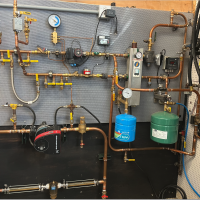Staple Up with Cantilever
I am planning a staple up installation in a newly constructed small addition. The area is 14’ x 20’ (kitchen) with conditioned space below (12’ x 18’). There are 2’ overhang/cantilevers on 2 sides. The spray foam guy is planning 4.5” closed cell foam in the overhang areas. My question is on the radiant. Can the loops be extended below the cantilevered areas? Construction would be radiant tubing in aluminum plates, air gap, reflective, then 4.5” of foam? If this is a bad idea, any other guidance? Thanks
Comments
-
Not a radiant expert others will comment but I would say it would be ok
0 -
-
JJust make sure it gets insulated and especially air sealed well and there aren't any voids enclosed during framing that get missed. My concern would be it would be easy for it to freeze if that isn't done.
Maybe home run it separately to the manifold in case something goes awry so you can isolate it.
0 -
People overestimate how much reflective barrier does. It is only about the equivalent to R2 of insulation (basically squat) so in most cases it is not worth the effort.
Make sure the installer carries the spray foam up the rim joist along the overhang and back down to the foundation. People often think stuffing batt insulation into places air seals, but this does nothing except filter the air leaks. You need something solid (spray foam or rigid insulation with canned foam) to air seal properly.
Make sure to fill the rest of the cavity with fluffy. There is nothing magical about spray foam. That 4.5" of ccSPF is about R25 long term (when installed it is higher, but looses R value over time), which is not a lot for an exposed floor like this.
What is the plan for the rest of the insulation? Generally with crawl you want to insulate the stem walls not under the rest of the floor. With heated floors you do want some R value under the floors though to limit the amount of heat going down, this can be pretty much anything. The cheapest batts you can stuff up TIGHT against the heat plate work great.
0 -
To better describe, this is a 2 story addition to existing house. The lower level (bedroom) is on a slab and there is radiant installed in the slab. Under the slab is 4” XPS. Exterior walls have zip sheathing with R6 foam. The upper level is a kitchen. I had planned to do quiktrak above the subfloor with radiant but contractor messed up floor height so it doesn’t match existing house floor - so now doing staple up to make it work. The second floor in the kitchen cantilevers on 2 sides 2’ out. This is the area I’m concerned about. Seems like what I’m hearing is install the radiant but keep it back from the exterior wall to allow spray foam between the piping and exterior. Then Insulate under.
0
Categories
- All Categories
- 87.3K THE MAIN WALL
- 3.2K A-C, Heat Pumps & Refrigeration
- 61 Biomass
- 429 Carbon Monoxide Awareness
- 120 Chimneys & Flues
- 2.1K Domestic Hot Water
- 5.8K Gas Heating
- 114 Geothermal
- 166 Indoor-Air Quality
- 3.7K Oil Heating
- 77 Pipe Deterioration
- 1K Plumbing
- 6.5K Radiant Heating
- 395 Solar
- 15.7K Strictly Steam
- 3.4K Thermostats and Controls
- 56 Water Quality
- 51 Industry Classes
- 50 Job Opportunities
- 18 Recall Announcements

